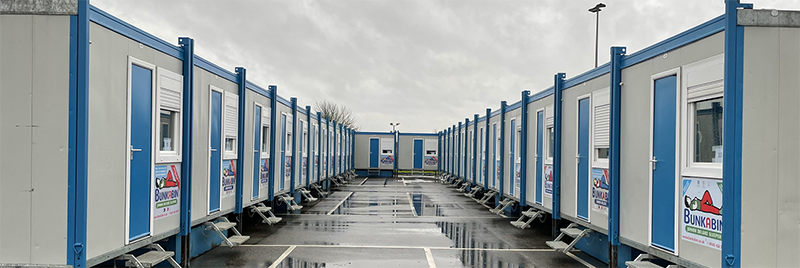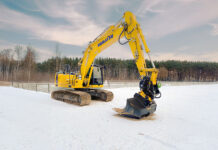Benjamin Rothwell, business development manager at Bunkabin, tells Project Plant how temporary accommodation can help to make construction sites more sustainable
AS the construction industry looks to become more sustainable, temporary accommodation is one way that sites can reduce their environmental impact. By using prefabricated buildings, construction companies can minimise the amount of waste produced on site and lower their carbon footprint. In addition, temporary solutions can be set up and running quickly to support workers on site.
Lower environmental impact
The environmental benefits that come from people living on site in temporary accommodations are often overlooked. People residing within a development or construction site minimise the need for commuting. This also reduces carbon emissions due to less workers needing to drive and lowers the overall environmental footprint of a project.
Temporary accommodation can also reduce energy usage if the cabins are built sustainably and adhere to environmental regulations regarding energy efficiency during use, such as by using efficient or solar-powered appliances. By reducing the overall carbon emission of individual projects, we can contribute positively towards making sites more sustainable.
Fewer resources used
Temporary accommodation can be instrumental in reducing the resources used on sites where more permanent accommodation buildings might otherwise have to be constructed.
Unlike construction of traditional accommodation buildings, which often require the use of large amounts of energy-intensive materials, temporary accommodation is lightweight with simple foundations that are easily installed with minimal disruption. This makes it an ideal solution for months or years of work that might otherwise involve complex and resource intensive groundwork.
With trusted suppliers able to deliver temporary structures quickly and in accordance with safety regulations, contractors and employers can be confident that their site will operate as efficiently as possible.
As these temporary structures are designed for one-time use, their eventual deconstruction means that they can be reused in future projects. By taking into account the lifecycle of these temporary spaces, businesses can ensure their sustainability practices result in fewer resources being used overall.
More efficient use of space
Temporary accommodation is becoming increasingly popular among businesses who are looking to make clever, efficient use of the space they have available. Its portability means that businesses can relocate the accommodation to wherever it is needed most, allowing them to use their land and space in a much more sustainable way. This can save resources in multiple ways, as well as allow temporary accommodation to be placed where permanent buildings may not.
Companies can rely on fewer permanent buildings and become more energy efficient due to lowered long-term use. Making more efficient use of available space brings a multitude of opportunities for increased sustainability that could benefit businesses in any industry.
Greater flexibility
There are many advantages to using temporary accommodation for construction sites that go beyond the need for convenience. One of the greatest benefits of portable and temporary accommodation is its flexibility; it can be relocated to fit the changing needs of a project or site with relative ease.
Additionally, temporary accommodation structures can be built with readily available materials that are easier to handle than those required to build long-lasting foundations. This flexibility reduces waste in construction materials and improves the installation time for temporary solutions.
Temporary accommodation can be customised and adapted to its surroundings and the needs of those working on the site. Site diversification is something that is becoming increasingly important in today’s ever-changing landscape and being able to separate cabins into areas that suit the needs of the inhabitants will lead to a better work environment for all.
Cost-effective
Using temporary accommodation for sites can be a great way to increase sustainability without driving costs through the roof. From initial site set-up to ongoing maintenance, these solutions can provide a cost-effective alternative when compared with traditional methods, such as hotel stays or commuting.
Unlike fixed-structure units, the innovative designs of modern temporary accommodation solutions means that they can be easily adapted using additional modules and components, and are built using materials that suit nearly any environment – making them not only low-cost but also adaptable to different needs all year round.
By reducing the need for commuting, using fewer resources and being more flexible, temporary accommodation can help to promote sustainability in the construction industry as well as other contexts.












